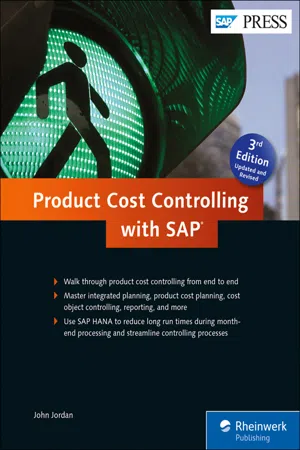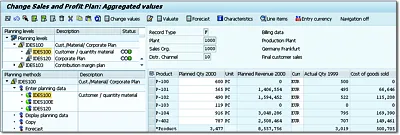
- 700 pages
- English
- ePUB (mobile friendly)
- Available on iOS & Android
Product Cost Controlling with SAP
About this book
Looking for a comprehensive guide to product costing in SAP (SAP CO-PC)? With this best-seller, you'll begin with a breakdown of how to manage master data and configure settings in SAP CO. Next, you'll learn the nitty-gritty details of integrated planning, from creating cost estimates to handling planned costs, actual costs, and final settlements. Contains coverage of SAP HANA, current trends in product cost controlling, and other new functionalities! Configuration Learn to manage your master data and tailor your configuration settings based on your particular business requirements. Functionality Understand and implement key functionalities including standard cost estimates, work in progress and variance calculations, reporting, and analysis. Advanced Topics Find answers to your questions about the Material Ledger, subcontracting, delivery costs, user exits, mixed-cost estimates, and more.
Highlights:
- Integration planning
- Master data
- Configuration settings
- Material Ledger confirmation
- Costing variants
- Unit cost estimates
- Simultaneous costings
- Overhead
- WIP calculations
- Settlement
- -Reporting and analysis
Frequently asked questions
- Essential is ideal for learners and professionals who enjoy exploring a wide range of subjects. Access the Essential Library with 800,000+ trusted titles and best-sellers across business, personal growth, and the humanities. Includes unlimited reading time and Standard Read Aloud voice.
- Complete: Perfect for advanced learners and researchers needing full, unrestricted access. Unlock 1.4M+ books across hundreds of subjects, including academic and specialized titles. The Complete Plan also includes advanced features like Premium Read Aloud and Research Assistant.
Please note we cannot support devices running on iOS 13 and Android 7 or earlier. Learn more about using the app.
Information
Part I
1Integrated Planning
1.1Profitability Analysis

- Transfer quantities to S&OP (or other components) by following the menu path Accounting • Controlling • Profitability Analysis • Planning • Integrated Planning.
- Create a planning scenario with Transaction MS31 and access the CO-PA data directly with long-term planning, which we'll discuss further in Section 1.4.
1.2Sales and Operations Planning
Table of contents
- Dear Reader
- Notes on Usage
- Table of Contents
- Preface
- Part I Integrated Planning
- 1 Integrated Planning
- Part II Product Cost Planning
- 2 Controlling Master Data
- 3 Material Master Data
- 4 Logistics Master Data
- 5 Costing Sheets
- 6 Cost Components
- 7 Costing Variant Components
- 8 Costing Variant Tabs
- 9 Standard Cost Estimates
- 10 Preliminary Cost Estimates
- 11 Unit Cost Estimates
- Part III Cost Object Controlling
- 12 Preliminary Costing
- 13 Simultaneous Costing
- 14 Overhead
- 15 Work in Process
- 16 Variance Calculations
- 17 Settlement
- 18 Special Topics
- Part IV Information System and Trends
- 19 Information System
- 20 Trends in Product Cost Controlling
- 21 Conclusion
- A Additional Resources
- B Bibliography
- C Glossary
- D The Author
- Index
- Service Pages
- Legal Notes